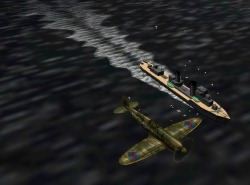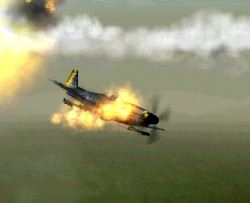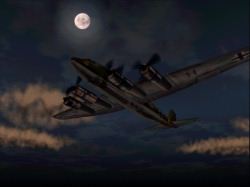| Interview with Craig Penrice, RAF Pilot and Consultant to
Nations - WWII Fighter Commandô
|
||||
|
This interview was supplied as a courtesy by Psygnosis. 1. You fly cutting-edge fighters and planes over fifty years old - which do you prefer? Them all! No two aircraft are the same, they all have strengths and weaknesses. Flying the old fighters gives a great insight into the way that air combat has developed alongside technology. The sounds and smells of these older aircraft are quite unique. Being "allowed" to play with a part of aviation heritage is a distinct privilege. I often wonder if the general public are really aware of the time, effort, dedication and money that is involved in keeping these aircraft in airworthy condition, fit to display at airshows. The teams I have been involved with are startling examples of true dedication and commitment. Modern fighters, Eurofighter in particular, have capabilities previously only dreamt of, even by contemporary fighter pilots. Aerial combat has changed in terms of its complexity, but the basic feature is two individuals pitting their skill and the capabilities of their aircraft against each other. It is in the end the man who makes the most of the machine, not the best machine, who wins. 2. Having flown these WWII aircraft, what do you think about the pilots who flew them in combat? When you consider the technology that accompanies the fighter pilot into battle today and consider what the WWII pilot had, I find the difference quite staggering. The basic traits of the fighter pilot remain the same; "he who sees wins", and you must know the strengths of your aircraft and the weaknesses of your opponents. WWII pilots were incredibly brave men who lived on their own abilities with limited training and an unshakable belief in what they were fighting for. 3. Are WWII planes easier or more difficult to fly than modern jets? They are definitely more difficult to fly than modern jets. Big piston aircraft in general are a handful anyway due to the effects of propeller torque and slipstream. Going back into a piston aircraft after a jet is always a re-education of what your feet are for; rudder pedals in a jet are foot rests after you are airborne, in a piston you are always using them to maintain balanced flight. 4. Have you been on a flight simulator or played a flight sim game before trying Nations - WWII Fighter Command? I have hundreds of hours flying in simulators of various standards, none of which could be considered to be viable home entertainment! Most of them are bigger than your average house. My previous PC flight sim experiences were fairly limited, this was mainly because I was frustrated that they were so far removed from what I know to be reality, there simply was not enough substance to them. Too many shortcuts taken and features omitted to make them anything like the real thing. I know the reasons for this were to make them "playable" for all levels of experience, but I found this less than satisfying. What is more, when my sons could do better at them than I could, that was simply not on! 5. You may have flown many of the actual aircraft featured in Nations - WWII Fighter Command, what's your experience with the game? My main experience in relation to Nations-Fighter Command is in the P-51 Mustang. I spent some time with the designers in trying to incorporate some of the features of the aircraft into the computer model of it. I think that the game has managed to achieve something that I have not experienced before in a computer game, that is a good balance between realistic aircraft handling characteristics and a game that is playable and enjoyable. |
It is very different sitting in your armchair in a nice warm and quiet room, connected to your PC game through a joystick, compared to being strapped tightly into a noisy, cold, windy aircraft where the 'G' forces associated with the maneuvers you are doing are draining the blood from your brain and making it difficult for you to see and move your head. Taking an all-encompassing 360 degree real life combat scenario and replicating it onto a two dimensional computer screen is very difficult indeed. 6. Were you involved in the development of the game? How did your experience in the real life aircraft help the developers achieve greater realism? I think my main input into the design process was to be able to help them make the model aircraft behave sufficiently like a real aircraft in the more advanced levels. If you have not flown in a combat aircraft you could be forgiven for thinking that you can simply thrash the joystick around willy-nilly without regard to altitude or airspeed. Reality is not like that. The term "Carefree Handling", has long been a designer's and pilot's dream, it is only with aircraft such as Eurofighter that this term is becoming reality. If you pull too hard when you are going fast you will break the aircraft, if you pull too hard when you are going too slow there is a high likelihood it will depart from controlled flight and end up in a spin. PC models lack the tactile cues of the real aircraft that allow a pilot to modulate his control inputs appropriately. Most PC game players also lack the years of flying experience required to operate the "real thing" effectively. There is a balance to be struck, I think Nations - WWII Fighter Command has managed to achieve that balance. 7. Is there anything that particularly impressed you about the game, was there something that made you sit up and say "Wow"? The graphics are very impressive indeed. The research that has gone into making each of the cockpits authentic has really paid off in my opinion. You really get the impression that you are in different cockpit with each aircraft, each has its own unique feel to it. That, on top of the realistic combat and the historical accuracy make it a great game. 8. Is there a particular plane, old or new, that you would give your eye-teeth to take for a spin? I think I would really like to fly something like the MIG-29 or more importantly the Su-27 or any of the later derivatives of this breed of aircraft. These were the threats that my contemporaries and I faced for years before the Berlin Wall came down. I would really like to see, first-hand, just what these aircraft are capable of. 9. You served in the RAF for a number of years, how long have you been flying? I served in the RAF for 18 years and 61 days to be precise. I know this because they tell you this on your exit paperwork, not because I was counting the days! I had a great time. My first flight as a student pilot was on January 4th 1977, in a Bulldog T Mk 1 of the University of Glasgow and Strathclyde Air Squadron. So to answer the question, I have been flying for over 22 years. Go to Part II
|
|||
|
© 1997 - 2000 COMBATSIM.COM, INC. All Rights Reserved Last Updated January 25th, 1999 |
||||



